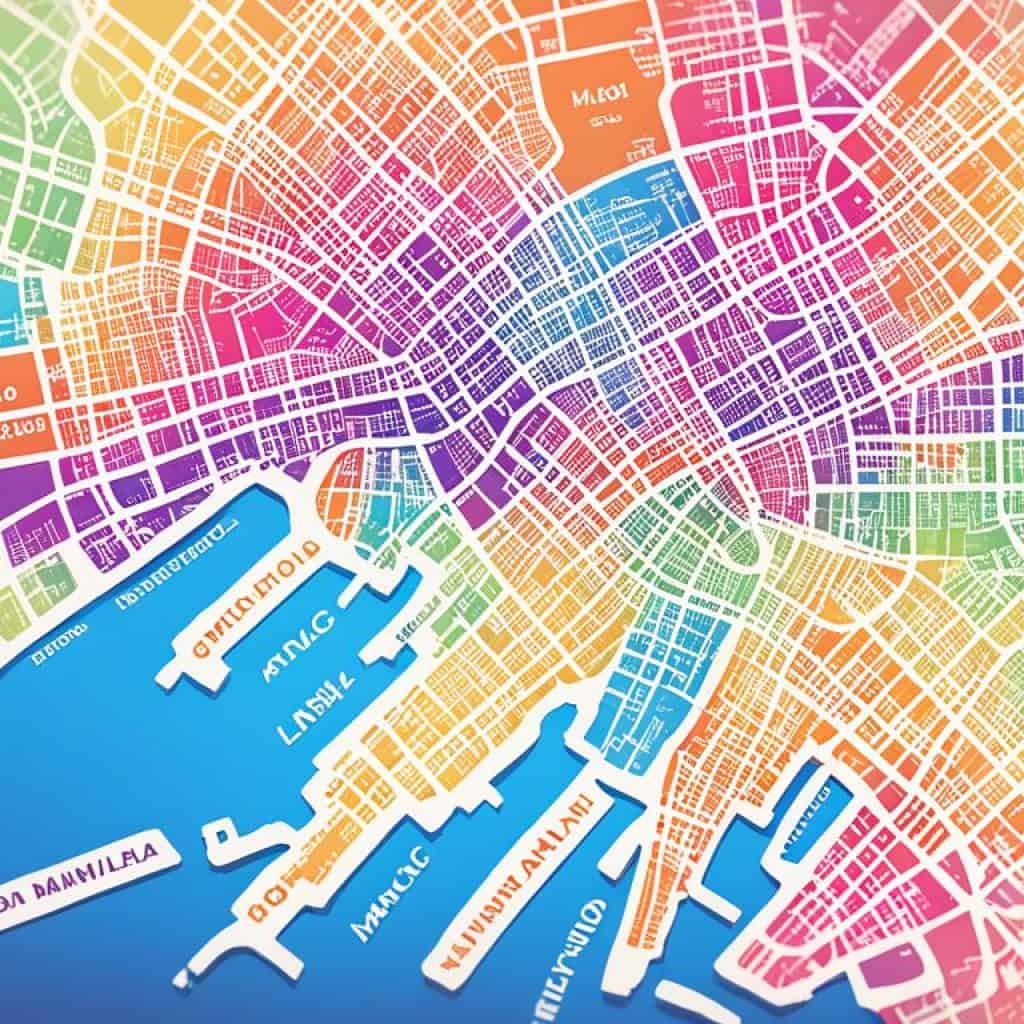Have you ever wondered what the postal code is for Camiguin? Or how to write addresses with zip codes accurately? Look no further! This comprehensive guide will provide you with all the information you need. Whether you’re a resident, business owner, or simply curious, understanding postal codes is essential for efficient mail delivery. Let’s dive into the world of Camiguin postal codes and explore how they play a crucial role in ensuring your mail reaches its destination hassle-free.
Key Takeaways:
- Camiguin is an island province located off the northern coast of mainland Mindanao in the Philippines.
- The province is divided into five municipalities: Catarman, Guinsiliban, Mahinog, Mambajao, and Sagay.
- Camiguin’s postal code range is 9100-9104.
- Knowing how to write addresses with zip codes correctly is crucial for accurate mail delivery.
- Postal codes serve as more than just geographic identifiers; they provide valuable data for businesses and help target specific areas for marketing campaigns.
Understanding ZIP Codes in the Philippines
In the Philippines, ZIP codes, also known as postal codes, play a crucial role in locating addresses for mail and package delivery. These four-digit numbers serve as identifiers for specific areas, including barangays (within a city) or towns and cities. It’s essential to include the correct ZIP code when writing addresses to ensure accurate and timely delivery of mail and packages.
While the ZIP codes used in the United States consist of five digits, the maximum number of digits utilized in the Philippines is four. This system allows for efficient routing of mail and packages, ensuring they reach the intended recipients in various regions throughout the country.
ZIP codes in the Philippines are essential for accurate mail and package delivery, enabling a seamless and reliable postal system.
“Using the correct ZIP code when writing addresses in the Philippines greatly improves the chances of accurate delivery. It helps the postal workers quickly sort and route mail to the right location, saving time and ensuring that items reach their intended destinations without delay.”
To understand the significance of ZIP codes, it’s important to realize that they go beyond their basic function as geographic identifiers. These codes also provide valuable social data, allowing businesses to analyze population demographics associated with specific ZIP codes. This information proves beneficial for businesses seeking to target specific areas for marketing campaigns and other purposes.
The Importance of Accurate ZIP Codes
Accurate ZIP codes are crucial for businesses in the Philippines, as they help in identifying potential customers and understanding their preferences. By analyzing the demographics associated with each ZIP code, businesses can tailor their marketing strategies and optimize their operations. The utilization of accurate ZIP codes ensures that businesses reach the right customers and effectively serve their needs.
Writing Addresses with ZIP Codes
When writing addresses in the Philippines, it is essential to follow the correct format for including ZIP codes. The general rule is to place the ZIP code on the left side of the last line of the address. The format should include the recipient’s name, unit/floor and building name, street number and name, barangay/district, city, ZIP code, and either “Metro Manila” or the province name.
The Role of ZIP Codes in Mail Delivery
ZIP codes play a crucial role in the efficient delivery of mail and parcels in the Philippines. These codes serve as a vital tool for postal workers, helping them quickly sort and route items to their respective destinations. By including the correct ZIP code in addresses, individuals and businesses contribute to a seamless and reliable mail delivery system.
Benefits of Using ZIP Codes
The benefits of using ZIP codes in the Philippines for addressing mail are numerous. By incorporating the correct ZIP codes, individuals eliminate errors in mail delivery and ensure items are sent to the correct locations. ZIP codes also provide businesses with valuable data, allowing for targeted marketing campaigns based on population demographics associated with each ZIP code. Ultimately, the proper use of ZIP codes enhances the efficiency and accuracy of mail delivery.
Importance of ZIP Codes
ZIP codes in the Philippines play a significant role beyond being mere geographic identifiers. They also serve as social identifiers that provide valuable data on a region’s population demographics. As businesses seek to understand their target audience and tailor their marketing strategies, ZIP codes become crucial data structures that help visualize and analyze their customer base.
ZIP codes provide businesses with a granular understanding of the communities they serve. By examining the demographics associated with specific ZIP codes, businesses can gain insights into the age, income level, occupation, and other social factors that shape consumer behavior. This information enables targeted marketing campaigns that resonate with specific segments of the population.
Moreover, ZIP codes allow businesses to optimize their operations. By analyzing the distribution of ZIP codes, companies can identify locations with high concentrations of their target audience, facilitating decisions on store locations, distribution centers, or the allocation of marketing resources. ZIP codes provide businesses with a geographical framework for effective decision-making.
For example, a clothing retailer can utilize ZIP code data to identify areas where their target demographic, such as young professionals, is most concentrated. This information can inform decisions on store openings or partnerships with local establishments in those ZIP code areas. By understanding the population characteristics associated with specific ZIP codes, businesses can make informed choices to maximize their market reach.
“ZIP codes are not just numbers; they are valuable insights into the people and communities we serve. By leveraging ZIP code data, businesses can unlock opportunities for growth and better understand their target audience.”
In conclusion, ZIP codes go beyond being mere numbers assigned to geographic areas. They are powerful social identifiers that provide businesses with valuable insights into population demographics. By harnessing ZIP code data, companies can make strategic decisions and tailor their marketing efforts to reach their target audience more effectively.
How to Write Addresses with ZIP Codes
When it comes to including ZIP codes in addresses, it’s essential to follow the correct format to ensure accurate delivery. The general rule is to place the ZIP code on the left side of the last line of the address. Let’s break down the format step by step:
- Recipient’s Name: Begin by including the recipient’s full name. This helps ensure that the mail is delivered to the intended person.
- Unit/Floor and Building Name: If the address includes a specific unit or floor number and building name, make sure to include this information next. For example, “Unit 1A, Acacia Tower.”
- Street Number and Name: Provide the street number followed by the street name. It’s important to be accurate and spell out the street name correctly to avoid any confusion. For instance, “123 Main Street.”
- Barangay/District: Include the name of the barangay or district where the address is located. This helps further pinpoint the exact location. For example, “Brgy. Bagong Silangan.”
- City: Write the name of the city or municipality where the address is situated. Ensure correct spelling and use the full name of the city, such as “Quezon City.”
- ZIP Code: Place the ZIP code on the left side of the last line of the address. This is a crucial step to enable accurate routing and delivery. For example, “1105.”
- Province or “Metro Manila”: Finally, indicate either the name of the province or “Metro Manila” to provide additional location information. For instance, “Metro Manila” or “Rizal.”
“Including the correct ZIP code in your address is vital for ensuring prompt and accurate delivery. By following the proper format, you can help the postal service efficiently process your mail and packages.”
Remember, using the correct format when writing addresses with ZIP codes helps streamline the delivery process and ensures that your mail reaches its intended recipient without any delay. By providing complete and accurate address information, you contribute to a seamless and reliable mail delivery system in your area.
ZIP Codes in Metro Manila
Metro Manila, the bustling capital region of the Philippines, encompasses several cities and one municipality. Each of these areas has its own unique set of ZIP codes, which play a vital role in ensuring efficient mail and package delivery across the region.
Let’s take a closer look at some of the ZIP codes in Metro Manila:
Caloocan ZIP Codes:
Caloocan, one of the larger cities in Metro Manila, has ZIP codes ranging from 1400 to 1409. These codes help deliver mail and packages accurately to the diverse neighborhoods in the city.
Las Piñas ZIP Codes:
Las Piñas, known for its vibrant cityscape, has a single ZIP code, which is 1740. This code ensures seamless mail delivery to residents and businesses within the city.
Malabon ZIP Codes:
Malabon, a city known for its rich cultural heritage, has ZIP codes 1409 and 1410. These codes are essential for postal workers to efficiently sort and deliver mail to different areas in Malabon.
Makati ZIP Codes:
Makati, the financial hub of the Philippines, has ZIP codes ranging from 1200 to 1235. These codes facilitate the smooth flow of mail to the bustling business district and residential areas in Makati.
Mandaluyong ZIP Codes:
Mandaluyong, a rapidly developing city in Metro Manila, has ZIP codes ranging from 1550 to 1556. These codes enable accurate mail delivery to the various districts and communities within Mandaluyong.
Manila ZIP Codes:
Manila, the capital city of the Philippines, has ZIP codes ranging from 1000 to 1018. These codes are crucial for hassle-free mail delivery to the vibrant neighborhoods, historical sites, and educational institutions in Manila.
Marikina ZIP Codes:
Marikina, known as the Shoe Capital of the Philippines, has ZIP codes ranging from 1800 to 1820. These codes ensure the smooth transit of mail to the bustling residential and industrial areas in Marikina.
These are just a few examples of the ZIP codes in Metro Manila. Each code represents a distinct area within the capital region, allowing mail and packages to reach their intended destinations promptly.
By including the correct ZIP code in your address, whether you live in Caloocan, Las Piñas, Malabon, Makati, Mandaluyong, Manila, Marikina, or any other city in Metro Manila, you can contribute to the efficient mail delivery system in the region. Remember to use the correct ZIP code to ensure that mail and packages are delivered accurately and without delay.
| City | ZIP Codes |
|---|---|
| Caloocan | 1400-1409 |
| Las Piñas | 1740 |
| Malabon | 1409-1410 |
| Makati | 1200-1235 |
| Mandaluyong | 1550-1556 |
| Manila | 1000-1018 |
| Marikina | 1800-1820 |
With the help of these ZIP codes, residents and businesses in Metro Manila can enjoy the convenience of timely and accurate mail delivery. So, make sure to include the correct ZIP code in your address and experience the efficiency of the postal system in the capital region.

ZIP Codes in Other Regions of the Philippines
Beyond Metro Manila, the rest of the Philippines also has designated ZIP codes for towns and cities within each province. These ZIP codes are used to accurately route mail and packages to their intended destinations. It is important to use the correct ZIP code when addressing mail to ensure timely and accurate delivery.
ZIP Codes for Provinces in the Philippines
Each province in the Philippines has its own set of ZIP codes to facilitate efficient mail delivery. These codes are essential for accurately directing mail to specific towns and cities within each province. By using the correct ZIP code, you can ensure that your mail reaches its intended destination promptly.
| Region | Province | ZIP Codes |
|---|---|---|
| Luzon | Batangas | 4200-4240 |
| Cebu | 6000-6025 | |
| Pampanga | 2000-2015 | |
| Visayas | Iloilo | 5000-5049 |
| Bohol | 6300-6344 | |
| Mindanao | Davao del Sur | 8000-8024 |
| Misamis Oriental | 9000-9032 |
These are just a few examples of the provinces in the Philippines and their respective ZIP codes. Each region and province has its unique set of codes to ensure efficient mail delivery across the country.
“Using the correct ZIP code is essential for prompt and accurate mail delivery in the Philippines. It ensures that your mail is accurately routed to the specific town or city within each province. Don’t forget to include the correct ZIP code when addressing your mail!”
To find the specific ZIP code for a particular province or town, you can refer to the official Philippine Postal Corporation website or consult local post offices for assistance. It’s always best to double-check the ZIP code to avoid any delays or misdeliveries.
The Role of ZIP Codes in Mail Delivery
ZIP codes play a crucial role in the efficient delivery of mail and parcels. These unique codes, also known as postal codes, help postal workers quickly sort and route items to their respective destinations. By including the correct ZIP code in addresses, individuals and businesses can help ensure that their mail arrives at the intended location in a timely manner.
Efficient mail routing is essential for a smooth and reliable postal service. When a mail item is sent, it goes through various stages, including collection, sorting, and delivery. The ZIP code acts as a key identifier during the sorting process, allowing postal workers to quickly categorize and organize mail based on their destination.
For example, when a mailpiece is collected, it is first sorted based on the initial digits of the ZIP code, which represent the general geographic area. Then, it is further sorted based on the specific ZIP code digits, allowing for precise routing to the intended city, town, or neighborhood.
In addition to facilitating efficient mail routing, ZIP codes also help minimize errors and delays in mail delivery. By providing the correct ZIP code, individuals and businesses can ensure that their mail is accurately directed to the correct location, reducing the risk of misdelivery or return to the sender.
The Benefits of Using ZIP Codes for Mail Delivery:
- Accurate and efficient mail routing
- Reduces errors and delays in delivery
- Enables precise targeting of specific areas for marketing or other purposes
- Provides valuable data on population demographics for businesses
By understanding the importance and role of ZIP codes in mail delivery, individuals and businesses can optimize their mailing processes, ensuring that their mail reaches its intended recipients in a timely and accurate manner.
Benefits of Using ZIP Codes
When it comes to addressing mail, using ZIP codes offers numerous benefits. These codes play a crucial role in eliminating errors and ensuring accurate delivery to the intended location. By including the correct ZIP code, you can have the peace of mind that your mail will reach its destination without any hiccups.
One of the major advantages of ZIP codes is their ability to streamline the mail delivery process. Postal workers rely on these codes to sort and route items efficiently, saving time and resources. With the use of ZIP codes, you can contribute to the smooth operation of the postal system, allowing mail and packages to be delivered in a timely manner.
Moreover, ZIP codes provide valuable data for businesses. Each ZIP code is associated with specific population demographics, allowing businesses to target their marketing efforts accordingly. By analyzing the demographics associated with each ZIP code, businesses can tailor their campaigns to reach their desired audience effectively.
Accurate Delivery Made Easy
Using ZIP codes ensures accurate delivery by minimizing the chances of errors or misplacement of mail. By including the correct ZIP code, you can rest assured that your correspondence will be sent to the correct address, regardless of how common the street or city name might be.
“ZIP codes eliminate errors and help ensure that items are sent to the correct location.”
ZIP codes also help in reducing delays in mail delivery. With accurate addresses that include the correct ZIP codes, postal workers can easily identify the intended destination, resulting in faster processing and delivery.
Targeting the Right Audience
For businesses, ZIP codes are a valuable tool for targeting specific areas and demographics. By analyzing the population data associated with each ZIP code, businesses can gain insights into the characteristics and preferences of the residents in those areas. This information enables businesses to tailor their marketing campaigns to resonate with the target audience, increasing the chances of success.
For example, a clothing retailer can use ZIP code data to identify areas with a higher concentration of their target demographic. They can then tailor their marketing efforts to those specific areas, ensuring that their message reaches the right customers who are more likely to be interested in their products.
Unlocking the Benefits
Using ZIP codes for accurate delivery and targeted marketing campaigns has numerous advantages. By including the correct ZIP codes when addressing mail, you can help eliminate errors and ensure that your correspondence reaches its intended destination swiftly and accurately. Additionally, businesses can leverage ZIP code data to target specific areas and demographics, optimizing their marketing efforts for better results.

Postal Code Information for Camiguin
Camiguin, a picturesque island province in the Bohol Sea, off the northern coast of mainland Mindanao, has a unique set of postal codes that ensure accurate mail and package delivery within the province. The postal codes in Camiguin range from 9100 to 9104, covering various areas across the island.
Residents and businesses in Camiguin play a vital role in facilitating efficient mail delivery by including the correct postal code when addressing their mail. This helps postal workers accurately sort and route items to their intended destinations, ensuring timely delivery.
Whether you’re sending a letter to a loved one or shipping products for your business in Camiguin, don’t forget to include the relevant postal code. This small but essential detail can make a significant difference in ensuring that your mail reaches its intended recipient without any hiccups.
The Importance of accurate Postal Codes
Accurate postal codes are essential for efficient mail delivery. They help postal workers identify the precise location of the recipient, ensuring that mail and packages are delivered to the correct destination in a timely manner.
By referencing the accurate postal codes in Camiguin, businesses can streamline their operations and enhance customer satisfaction. Whether you’re running an e-commerce store or a local business, using the correct postal code when addressing packages can help minimize delivery errors and improve overall logistics.
Postal codes in Camiguin are not just random numbers; they represent specific areas within the province. Including the correct postal code in your address is like providing GPS coordinates to your package, ensuring smooth navigation and delivery.
To further emphasize the significance of postal codes, here is a table showcasing the postal codes for the different municipalities in Camiguin:
| Municipality | Postal Code |
|---|---|
| Catarman | 9100 |
| Guinsiliban | 9101 |
| Mahinog | 9102 |
| Mambajao | 9103 |
| Sagay | 9104 |
Now that you have the information you need about postal codes in Camiguin, you can ensure accurate and efficient mail and package delivery within the province. Remember to check the correct postal code, include it in your addresses, and enjoy hassle-free delivery!
Exploring Camiguin’s Unique Features
Camiguin is a province in the Philippines that offers a range of unique features and attractions for visitors to explore. From its famous sweet lanzones to its lush forests and cultural treasures, Camiguin has something for everyone.
Sweet Lanzones and the Lanzones Festival
Camiguin is renowned for its sweet lanzones, a tropical fruit that grows abundantly on the island. Every third week of October, the province celebrates the Lanzones Festival, where locals and tourists come together to enjoy the bountiful harvest and take part in various festivities. The festival is a colorful and lively event that showcases the rich agricultural heritage of Camiguin.
Mount Hibok-Hibok Protected Landscape
For nature lovers and outdoor enthusiasts, Camiguin is home to the Mount Hibok-Hibok Protected Landscape. This majestic mountain is part of the Camiguin Volcanic Group and is recognized as an ASEAN Heritage Park. Visitors can explore the lush forests, hike the trails, and experience the breathtaking views from the summit. It is a haven for adventure and nature tourism.
National Cultural Treasures and Important Cultural Treasures
Camiguin is proud to be the custodian of several National Cultural Treasures and Important Cultural Treasures. These landmarks and historical sites are recognized for their cultural and historical significance to the province and the country as a whole. Visitors can immerse themselves in the rich history and heritage of Camiguin by exploring these cultural treasures.
“Camiguin offers a captivating blend of natural wonders and cultural heritage. From the sweetness of lanzones to the awe-inspiring landscapes, this province truly has unique features that will leave visitors enchanted.”
Exploring Camiguin’s unique features is an opportunity to discover the beauty and charm of this Philippine province. Whether it’s indulging in the sweetness of lanzones, immersing in nature at Mount Hibok-Hibok, or delving into the rich cultural heritage, Camiguin promises a memorable experience for all.
The History and Etymology of Camiguin
Camiguin, an island province in the Philippines, has a fascinating history that stretches back to its early inhabitants, believed to be the Manobo people. The name “Camiguin” has an interesting etymology and is derived from the native word “Kamagong.” This word refers to the ebony tree, a species found in Surigao del Norte, the place of origin for the early inhabitants of Camiguin.
Throughout its history, Camiguin has experienced the influence of various colonial powers. During the Spanish colonial rule, the island played a significant role in the trading routes of the Spanish galleons. Later, Camiguin became significant during the American invasion era, contributing to the historical narrative of the region.
“Camiguin’s history is a tapestry woven with the stories of its indigenous people, colonial influences, and its role in key moments of the Philippines’ past.”
Exploring the history and etymology of Camiguin provides insights into the island’s cultural heritage and its connections to the broader history of the Philippines. It is a testament to the diverse influences that have shaped Camiguin into the vibrant destination it is today.
Geography and Administrative Divisions of Camiguin
Camiguin is a pearl-shaped island located in the Bohol Sea and is the second-smallest province in the Philippines in terms of both population and land area. The province’s geography is characterized by its stunning natural features, which attract both locals and tourists alike.
The island is home to breathtaking mountains, lush forests, and golden beaches, making it a paradise for nature lovers. One of the prominent mountain peaks on Camiguin is Mount Hibok-Hibok, which stands at an elevation of 1,332 meters. Its verdant slopes showcase the island’s rich biodiversity, supporting a variety of plant and animal species.
Besides its natural wonders, Camiguin also boasts a well-maintained national road that encircles the entire island. This road provides easy access to the different municipalities and barangays within Camiguin, allowing residents and visitors to explore the province conveniently.
Municipalities of Camiguin
Camiguin is divided into five municipalities, each with its own unique charm:
- Catarman: Located in the northern part of the island, Catarman is known for its stunning white beaches and beautiful diving spots. Visitors can explore the sunken cemetery, a popular tourist attraction.
- Guinsiliban: Situated on the eastern coast, Guinsiliban is known for its tranquil shoreline and historical landmarks such as the Old Enriqueta House.
- Mahinog: Mahinog is a municipality that offers picturesque views of the sea and is known for its pristine beaches. The town is also home to the popular White Island, a sandy islet located just off the coast.
- Mambajao: As the capital municipality of Camiguin, Mambajao serves as the center of commerce, education, and government. It is home to resorts, restaurants, and other amenities catering to visitors.
- Sagay: Located on the western side of the island, Sagay is known for its beautiful waterfalls, including Katibawasan Falls and Tuasan Falls. It is also known for its agricultural products, such as coconut and lanzones.
Each municipality in Camiguin is further divided into barangays or districts, ensuring effective governance and community organization throughout the province.
The image above showcases the stunning geography of Camiguin, capturing its picturesque mountainous landscapes, lush forests, and idyllic coastal areas.
Summary Table: Administrative Divisions of Camiguin
| Municipality | Barangays |
|---|---|
| Catarman | 14 |
| Guinsiliban | 6 |
| Mahinog | 12 |
| Mambajao | 15 |
| Sagay | 10 |
The table above provides an overview of the administrative divisions in Camiguin, listing the number of barangays in each municipality. These divisions help in governing and ensuring efficient services for the island’s residents.
Conclusion
In conclusion, understanding and using the correct postal codes, or ZIP codes, in Camiguin and the Philippines is crucial for accurate and efficient mail delivery. Postal codes help ensure that mail and packages reach their intended recipients in a timely manner. By following the correct format for writing addresses with postal codes, individuals and businesses can contribute to a seamless mail delivery system in Camiguin.


















Add comment